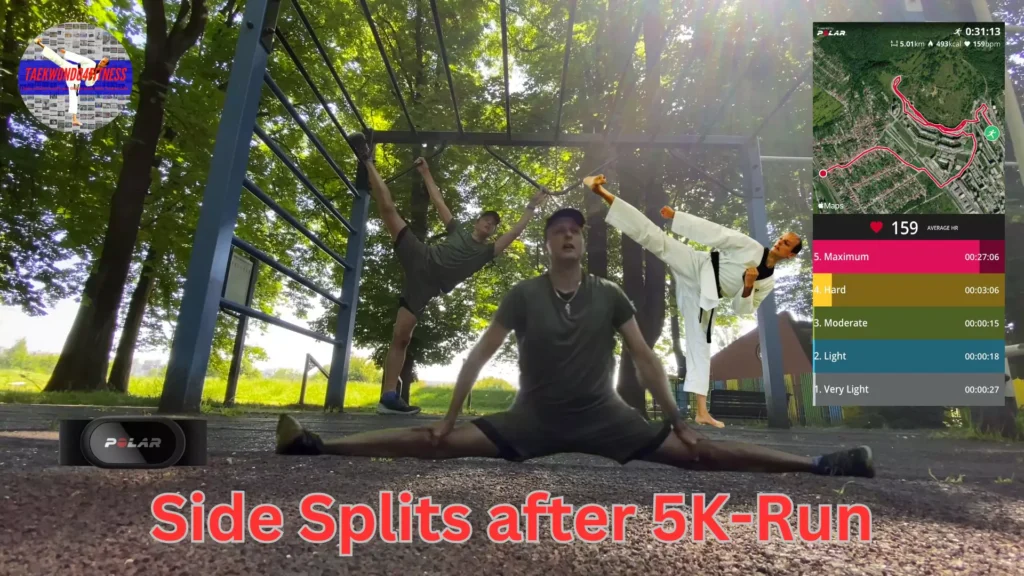How To Achieve Side Splits: A Step-by-Step Guide for Maximum Flexibility
Table of Contents
Introduction
The side splits, also known as straddle splits, are an impressive display of flexibility and strength that can benefit martial artists, dancers, and fitness enthusiasts alike. At Taekwondo4Fitness, we believe that achieving side splits is not just about flexibility; it’s about perseverance, self-control, and the indomitable spirit inherent in Taekwondo. In this guide, we’ll explore how you can achieve side splits through consistent practice and dedication.
Why Side Splits?
Side splits offer numerous benefits that extend beyond simply showcasing impressive flexibility. Whether you’re a martial artist, dancer, athlete, or fitness enthusiast, incorporating side splits into your training routine can provide significant advantages:
Improved Flexibility
Side splits are excellent for enhancing the flexibility of your hip adductors, hamstrings, and groin muscles. This increased flexibility is not only beneficial for performing splits but also translates to improved performance in various physical activities. Flexible muscles are less prone to injuries, allowing for a greater range of motion in daily movements and specific exercises. For martial artists, this means higher kicks and more fluid movements, while dancers can achieve more graceful and expansive motions.
Increased Range of Motion
A greater range of motion is crucial for activities that require wide leg movements, such as martial arts, dance, gymnastics, and certain athletic sports. Achieving side splits helps lengthen the muscles and tendons, enabling you to move your legs farther apart. This can enhance your overall athletic performance by allowing you to execute movements with greater ease and efficiency. For instance, in Taekwondo, a wider range of motion can improve your ability to perform high kicks and evasive maneuvers.
Enhanced Muscle Strength
While flexibility is a primary focus, side splits also help in strengthening the muscles around the hips and thighs. The process of working towards side splits engages and builds strength in the hip flexors, quadriceps, and glutes. Stronger muscles support better stability and control, which are essential for both dynamic and static movements. This increased muscle strength can aid in preventing injuries, supporting overall leg power, and enhancing endurance.
Better Posture and Balance
Practicing side splits promotes proper alignment and improves balance. Maintaining the correct posture while working towards and holding the side splits position encourages a neutral spine and proper pelvic alignment. This translates to better posture in everyday activities, reducing the risk of back pain and improving overall spinal health. Additionally, the balance required to perform side splits can enhance your coordination and proprioception, leading to improved balance in other physical activities and daily life.
Reduced Muscle Tension and Stress
Regular stretching, including practicing side splits, can help reduce muscle tension and alleviate stress. Stretching promotes relaxation and increases blood flow to the muscles, helping to relieve tightness and discomfort. This can be particularly beneficial after intense workouts or long periods of sitting. Incorporating side splits into your routine can contribute to overall well-being, reducing physical and mental stress and enhancing your sense of relaxation and calmness.
In summary, side splits offer a comprehensive range of benefits that contribute to your physical fitness and overall health. By improving flexibility, increasing range of motion, enhancing muscle strength, and promoting better posture and balance, side splits can significantly elevate your performance in various physical activities and sports. Embrace the journey of achieving side splits, and enjoy the multitude of advantages it brings to your body and mind.
Steps to Achieve Side Splits

Achieving side splits requires patience and consistent effort. Here’s a step-by-step guide to help you reach your flexibility goals:
Warm-Up
Begin with a proper warm-up to increase blood flow to your muscles. Light cardio exercises like jogging or jumping jacks are effective for preparing your body for stretching. A thorough warm-up helps prevent injuries and prepares the muscles for the stretching routine.
Stretching Routine
Seated Forward Bend:
Sit on the floor with your legs extended. Slowly reach towards your toes, aiming to touch them or go beyond if possible. This stretch targets the hamstrings and lower back. Hold the stretch for 30 seconds, breathing deeply to maximize the stretch’s effectiveness.
Butterfly Stretch:
Sit with the soles of your feet together, allowing your knees to fall out to the sides. Gently press the knees down towards the floor to deepen the stretch in the inner thighs and groin. Hold this position for 30 seconds to a minute, ensuring you maintain an upright posture.
Wide-Legged Forward Fold:
Stand with your legs wide apart, keeping your feet parallel. Slowly fold forward from the hips, reaching towards the floor. This stretch targets the inner thighs and hamstrings. Try to keep your back flat and hold the position for 30 seconds to a minute, allowing your body to relax into the stretch.
Dynamic Stretches
Incorporate dynamic stretches such as leg swings and hip circles to prepare the muscles for deeper stretches. Dynamic stretching involves moving parts of your body and gradually increasing reach, speed of movement, or both. This helps in warming up the muscles and increasing the range of motion.
Leg Swings:
Stand next to a wall or support for balance. Swing one leg forward and backward in a controlled manner, gradually increasing the range of motion. Perform 10-15 swings on each leg.
Hip Circles:
Stand with feet shoulder-width apart. Place your hands on your hips and make large circles with your hips, rotating clockwise and then counterclockwise. Perform 10 circles in each direction to loosen up the hip joints.
Progressive Splits Practice
Seated Wide-Legged Position:
Begin by sitting on the floor with your legs extended in front of you. Gradually widen the legs as far as you comfortably can, ensuring both legs remain straight. This is the starting position for progressing into the side splits.
Use Supports:
As you deepen into the split, use supports like yoga blocks, cushions, or folded blankets to support your body. Place them under your thighs or hips to reduce strain and help maintain balance. This allows you to hold the position longer and work towards deeper stretches.
Gradual Progression:
Move deeper into the stretch incrementally. Hold each position for 30 seconds to a minute, breathing deeply to relax the muscles. As you become more comfortable, gradually increase the stretch by widening your legs further or lowering the supports.
Consistency and Patience:
Regular practice is key. Aim to stretch at least 4-5 times a week, if not daily. Progress might be slow, but consistency will lead to improvement. Listen to your body and avoid pushing too hard to prevent injuries.
Cool Down:
After your splits practice, spend a few minutes performing gentle stretches to relax the muscles and prevent soreness. This could include light stretching of the legs, hips, and lower back.
By following these steps and incorporating them into your regular fitness routine, you’ll progressively improve your flexibility and move closer to achieving the side splits. Remember, the journey to achieving side splits is as important as the goal itself, fostering discipline, perseverance, and a deeper understanding of your body’s capabilities.
Tips for Success

Achieving side splits is a rewarding but challenging process that requires dedication and mindful practice. Here are some essential tips to help you succeed:
Consistency is Key
Regular practice is crucial for progress. Aim to include stretching and flexibility exercises in your routine at least 3-4 times a week. However, it’s important not to overdo it. Pushing your muscles too hard can lead to injuries, setting back your progress. A consistent, moderate approach ensures steady improvement and helps prevent burnout and injuries.
Listen to Your Body
Stretching should always be done with awareness. You should feel a gentle pull or mild discomfort in the muscles, but never sharp pain. Pain is your body’s way of signaling that something is wrong. If you experience sharp or intense pain, stop immediately and adjust your approach. Learning to distinguish between discomfort and pain is essential to avoid over-stretching and potential injuries.
Use Props
Yoga blocks, straps, or cushions can be invaluable tools in your stretching routine. These props provide support and stability, helping you maintain proper alignment as you work towards deeper stretches. They also allow you to gradually increase the intensity of your stretches without risking injury. For example, you can use yoga blocks to support your hands as you lower into the side splits, reducing strain on your muscles and joints.
Professional Guidance
Working with a coach or instructor can significantly enhance your stretching routine. Professionals can provide personalized advice, correct your form, and offer motivation and encouragement. They can help you set realistic goals and track your progress, ensuring that you are stretching safely and effectively. Additionally, they can introduce new techniques and exercises tailored to your needs, keeping your routine engaging and challenging.
Additional Tips for Achieving Side Splits
Warm Up Properly
Always start your stretching routine with a thorough warm-up. This increases blood flow to the muscles, making them more pliable and reducing the risk of injury. Light cardio exercises such as jogging, jumping jacks, or dynamic stretches like leg swings and hip circles are excellent ways to prepare your body for deeper stretching.
Maintain Good Posture
Good posture is critical in all stretching exercises. Ensure that your back is straight, shoulders are relaxed, and your core is engaged. Proper alignment helps you target the right muscles and avoid compensating with other parts of your body, which can lead to imbalances and injuries.
Hydration and Nutrition
Staying hydrated and maintaining a balanced diet are often overlooked aspects of flexibility training. Proper hydration keeps your muscles supple and reduces the risk of cramps. A diet rich in vitamins, minerals, and protein supports muscle recovery and growth, enhancing your overall flexibility and performance.
Patience and Perseverance
Achieving side splits takes time, and progress can sometimes be slow. Stay patient and keep a positive mindset. Celebrate small milestones along the way and remind yourself of the benefits you are gaining through your practice. Consistency, combined with patience and perseverance, will ultimately lead to success.
By following these tips and incorporating them into your stretching routine, you will be well on your way to achieving side splits. Remember, the journey is just as important as the destination, and every step forward is a victory. Stay committed, listen to your body, and enjoy the process of becoming more flexible and resilient.
Timeline for Achieving Side Splits
The time it takes to achieve side splits varies greatly among individuals. This timeline depends on several factors, including your initial flexibility, consistency in practice, and adherence to proper techniques. Here’s a rough estimate based on different starting points:
Initial Flexibility:
Those with a higher starting level of flexibility may achieve splits faster than those with less initial flexibility.
Consistency:
Regular, dedicated practice is crucial. Stretching a few times a week may take longer than daily practice.
Age:
Younger individuals often find it easier to gain flexibility, though it is achievable at any age with proper effort.
Body Structure:
Natural anatomical differences can affect the speed of progress.
Previous Injuries:
Any past injuries may slow down the process as the body needs more time to adapt.
Beginners:
If you are starting with limited flexibility, expect it to take anywhere from 6 months to a year or more. Beginners often need more time to build the necessary flexibility and strength in the hip adductors, hamstrings, and groin muscles. It’s important to focus on gradual progress and avoid pushing too hard too quickly, which can lead to injuries
Intermediate:
Individuals with a moderate level of flexibility may achieve side splits in 3 to 6 months. If you already have some experience with stretching and flexibility exercises, your muscles and joints are likely more adapted to the demands of side splits. Regular practice and consistent effort will help you reach your goal within this timeframe.
Advanced:
For those who already possess significant flexibility, achieving side splits might take only a few weeks to a few months. Advanced practitioners often have a well-developed range of motion and strength, making the final push to side splits quicker. However, even advanced individuals should remain mindful of their body’s limits to prevent overuse injuries.
Key Factors Influencing Your Timeline

Lorem ipsum dolor sit amet, consectetur adipiscing elit. Ut elit tellus, luctus nec ullamcorper mattis, pulvinar dapibus leo.
Consistency:
The more regularly you practice, the quicker you will see results. Aim for daily stretching sessions, incorporating both dynamic and static stretches to gradually increase your flexibility.
Proper Technique:
Ensuring you use the correct form during stretches is crucial. Incorrect techniques can lead to strains and injuries, setting back your progress. Consider consulting with a coach or following guided routines to maintain proper alignment and form.
Body Awareness:
Listen to your body and respect its limits. While slight discomfort is normal during stretching, sharp pain is a sign to stop and reassess your approach. Pushing too hard can cause injuries that significantly delay your progress.
Warm-Up and Cool-Down:
Properly warming up before stretching and cooling down afterward can enhance your flexibility gains and reduce the risk of injury. Incorporate light cardio and dynamic stretches in your warm-up, and finish with gentle stretches to cool down.
Hydration and Nutrition:
Staying hydrated and maintaining a balanced diet supports muscle health and recovery. Proper hydration keeps your muscles supple, while nutrients like protein help repair and build muscle tissue.
Tips for Staying Motivated
Set Realistic Goals:
Break down your ultimate goal of achieving side splits into smaller, manageable milestones. Celebrate each small victory to stay motivated.
Track Your Progress:
Keep a journal or take photos to document your flexibility improvements over time. Seeing your progress visually can be a powerful motivator.
Join a Community:
Engage with others on the same journey. Whether it’s a class, an online forum, or a social media group, sharing experiences and tips can provide encouragement and accountability.
Stay Patient and Positive:
Progress can be slow and nonlinear, but maintaining a positive mindset and being patient with yourself are essential for long-term success.
By following these guidelines and remaining dedicated to your practice, you can achieve side splits and enjoy the numerous benefits of enhanced flexibility and strength. Remember, every step forward is progress, no matter how small. Stay motivated, and keep pushing towards your goal.
Incorporating Taekwondo Principles
Integrating the principles of Taekwondo into your journey to achieving side splits not only aligns with martial arts training but also enhances your overall approach to fitness and well-being. Here’s how the core tenets of Taekwondo can guide and inspire you through this process:
Etiquette and Modesty:
Respect Your Body’s Limits
It’s essential to listen to your body and understand its current capabilities. Pushing beyond your limits can lead to injuries, setting back your progress. Approach each stretching session with mindfulness and respect for what your body can handle on that day.
Be Honest About Your Progress:
Self-assessment is crucial. Celebrate small victories and recognize areas that need more attention. Keeping a training journal can help track improvements and identify patterns in your flexibility journey.
Perseverance and Self-Control:
Consistency is Key:
Achieving side splits is a gradual process that requires regular practice. Dedicate time each day or week specifically for flexibility training. Consistent effort will yield the best results over time.
Maintain Discipline:
Stick to your routine even when progress seems slow. Set realistic goals and milestones to stay motivated. Remember that flexibility improves incrementally, and each session brings you closer to your goal.
Indomitable Spirit:
Stay Motivated and Resilient:
There will be days when progress seems stagnant or setbacks occur. It’s important to stay positive and keep pushing forward. Visualize your end goal and remind yourself why you started this journey.
Embrace Challenges:
Every challenge is an opportunity for growth. Facing difficulties head-on with a positive mindset will strengthen your resolve and improve not just your physical flexibility, but also your mental fortitude.
By integrating these steps into your training routine, you can achieve side splits and enjoy the benefits of enhanced flexibility and strength. At Taekwondo4Fitness, we’re here to support you on your journey to better flexibility and overall fitness. Our programs are designed to help you develop not only your physical abilities but also the mental discipline and resilience that are key to success in both martial arts and life.
Remember, achieving side splits is a journey that requires patience, dedication, and the right mindset. By applying the principles of Taekwondo, you can navigate this journey more effectively and achieve your flexibility goals. Stay committed, keep stretching, and enjoy the process of becoming stronger and more flexible.
For more personalized guidance and support, join our community at Taekwondo4Fitness. Together, we can help you reach your full potential in martial arts and beyond.
Related Blog Posts
For those looking to deepen their understanding of flexibility and enhance their martial arts practice, check out our other insightful blog posts. Discover essential tools and techniques for achieving improved splits in “Flexibility Mastery: Tools for Improved Splits” and gain advanced strategies with “Effortless Flexibility: Mastering Splits.” Enhance your kicking techniques with “High Kicks in Taekwondo: Training Strategy” and learn crucial post-run routines in “Post-Run Stretching Exercises: Essential After a 10K.”
Stay updated with the latest technology in “Best Fitness Trackers in 2024: Path to Health” and organize your fitness journey with “Fitness & Wellness Planners: Shop PlanFitCraft.” Fuel your Taekwondo training with nutritious choices from “Superfoods: Fueling Your Taekwondo Journey” and explore the benefits of supplements in “Healthy Food Supplements” and our comprehensive “Food Supplements Guide.” Each of these posts provides valuable insights and practical advice to support your journey towards greater flexibility, fitness, and overall well-being.
Feel free to click on the links to explore more:
- Flexibility Mastery: Tools for Improved Splits
- Effortless Flexibility: Mastering Splits
- High Kicks in Taekwondo: Training Strategy
- Post-Run Stretching Exercises: Essential After a 10K
- Best Fitness Trackers in 2024: Path to Health
- Fitness & Wellness Planners: Shop PlanFitCraft
- Superfoods: Fueling Your Taekwondo Journey
- Healthy Food Supplements
- Food Supplements Guide
These resources are designed to help you achieve your fitness goals with expert advice and practical tips.
Disclaimer
This post contains affiliate links. If you purchase through these links, we may earn a small commission at no additional cost to you.
Conclusion
Achieving side splits is a rewarding journey that enhances your flexibility, strength, and overall well-being. Follow these steps, stay consistent, and remember the principles of Taekwondo as you work towards your flexibility goals.
For more tips and guidance, visit Taekwondo4Fitness and join our community of dedicated martial artists and fitness enthusiasts.






